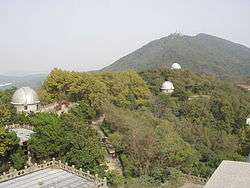Purple Mountain Observatory
|
Purple Mountain Observatory | |
| Organization | Chinese Academy of Sciences |
|---|---|
| Code | 330 |
| Location | Nanjing, Jiangsu province, China |
| Coordinates | 32°04′N 118°49′E / 32.067°N 118.817°ECoordinates: 32°04′N 118°49′E / 32.067°N 118.817°E |
| Altitude | 267 m (876 ft) |
| Established | 1934 |
| Website | www.pmo.ac.cn/ |
|
| |
The Purple Mountain Observatory (Chinese: 紫金山天文台; pinyin: Zĭjīnshān Tiānwéntái), also known as Zijinshan Astronomical Observatory, is an astronomical observatory located on the Purple Mountain in Nanjing, China. [lower-alpha 1] The longtime director of the observatory from 1950 to 1984 was Chinese astronomer Zhang Yuzhe (张钰哲, 1902–1986, also known as Y. C. Chang).
By the late 1980s, increasing light pollution in Nanjing meant Purple Mountain was no longer viable as a working observatory. It has since shifted its focus to public education, with much of the actual scientific work being carried out in its five branch observatories located at Qinghai (in Delingha), Ganyu, Xuyi, Honghe (in Jiamusi), and Qingdao.
The Minor Planet Center credits the observatory with the discovery of 149 minor planets between 1955 and 1983, while the observatory's PMO NEO Survey Program is credited with a total of 532 discoveries between 2006 and 2013.[1]
Discoveries
The observatory discovered the periodic comets 60P/Tsuchinshan and 62P/Tsuchinshan, as well as the non-periodic C/1977 V1 (Tsuchinshan), also known as Comet 1977 X. Many asteroids were also discovered, including the Trojan asteroids 2223 Sarpedon, 2260 Neoptolemus, 2363 Cebriones, 2456 Palamedes, and the eponymous 3494 Purple Mountain.
Near-Earth Object Survey
The Chinese Near-Earth Object Survey (CNEOS), based at Xuyi Observation Station,[2] started observations in 2006. It uses a 1:04=1:20=1:80 m Schmidt telescope equipped with a 4K by 4K CCD detector with the drift-scanning function.[3]
As of August 2012, the program has observed 149,971 asteroids, found 1,279 new provisional designation asteroids, and cataloged 251 numbered asteroids including five Jupiter Trojans, two Hildas, and one Phocaea. The program has also observed the position of 824 near-Earth objects (NEOs) and discovered four new ones: the Apollo asteroid (285339) 1999 JR6, and the three Amor asteroids (410195) 2007 RT147, (388567) 2007 QX14, and 2009 MZ6, still unnumbered as of 2016.[4][5]
List of discovered minor planets (1955–1983)
A total of 149 minor planets were discovered by the Purple Mountain Observatory between 1955 and 1983.[1]
|
|
|
|||||||||||||||||||||||||||||||||||||||||||||||||||||||||||||||||||||||||||||||||||||||||||||||||||||||||||||||||||||||||||||||||||||||||||||||||||||||||||||||||||||||||||||||||||||||||||||||||||||||||||||||||||||||||||||||||||||||||||||||||||||||||||||||||||||||||||||||||||||||||||||||||||||||||||||
List of discoveries by the PMO NEO Survey Program 2006–2013
A total of 532 minor planets were discovered by the observatory's PMO NEO Survey Program from 2006 to 2013.[1]
| Discoveries by the PMO NEO Survey (selection)[1] | |
|---|---|
| 171448 Guchaohao | 11 September 2007 |
| 175633 Yaoan | 9 October 2007 |
| 185535 Gangda | 28 November 2007 |
| 185538 Fangcheng | 14 December 2007 |
| 185640 Sunyisui | 1 March 2008 |
| 187707 Nandaxianlin | 2 March 2008 |
| 187709 Fengduan | 3 March 2008 |
| 188973 Siufaiwing | 3 March 2008 |
| 192178 Lijieshou | 3 October 2007 |
| 199947 Qaidam | 16 April 2007 |
| 199953 Mingnaiben | 18 April 2007 |
| 200002 Hehe | 6 May 2007 |
| 200003 Aokeda | 19 May 2007 |
| 202784 Gangkeda | 29 February 2008 |
| 204836 Xiexiaosi | 16 August 2007 |
| 204839 Suzhouyuanlin | 16 August 2007 |
| 207681 Caiqiao | 16 August 2007 |
| 210210 Songjian | 16 August 2007 |
Image gallery
- Gate of the Purple Mountain Observatory
References
- ↑ As of 2016, the Minor Planet Center lists 532 discovered bodies by the PMO NEO Survey Program between 2006 and 2013. However, the MPC lists another 3 discoveries by the PMO Neo Survey Program for 2007. Minor Planet Center – Minor Planet Discoverers
- 1 2 3 4 5 6 7 "Minor Planet Discoverers (by number)". Minor Planet Center. 24 February 2016. Retrieved March 2016. Check date values in:
|access-date=(help) - ↑ "Xuyi Observation Station, Purple Mountain Observatory". Purple Mountain Observatory. Retrieved 26 February 2015.
- ↑ Zhao, Haibin; et al. "The new NEO survey project - Chinese Near Earth Object Survey (CNEOS)" (PDF). Lunar and Planetary Institute: Asteroids, Comets, Meteors (2008 conference). Retrieved 26 February 2015.
- ↑ "Near Earth Asteroids (NEAs) – A Chronology of Milestones – Page 2 (see Oct 2, 2006)". IAU (International Astronomical Union). Retrieved 26 February 2015.
- ↑ "JPL Small-Body Database Browser: (2009 MZ6)" (2009-08-15 last obs.). Jet Propulsion Laboratory. Retrieved March 2016. Check date values in:
|access-date=(help)
External links
| Wikimedia Commons has media related to Purple Mountain Observatory. |
- Purple Mountain Observatory website (English) (Chinese)

